HiPACC Data Science Press Room. From: LLNL
The Data Science Press Room highlights computational and data science news in all fields *outside of astronomy* in the UC campuses and DOE laboratories comprising the UC-HiPACC consortium. The wording of the short summaries on this page is based on wording in the individual releases or on the summaries on the press release page of the original source. Images are also from the original sources except as stated. Press releases below appear in reverse chronological order (most recent first).
October 20, 2014 — Supercomputers link proteins to drug side effects

LLNL researchers Monte LaBute (left) and Felice Lightstone (right) were part of a team that published an article in PLOS ONE detailing the use of supercomputers to link proteins to drug side effects. Credit: Julie Russell/LLNL
LLNL 10/20/2014—New medications have helped millions of Americans. But the drug creation process often misses many adverse drug reactions (ADRs) or side effects that kill at least 100,000 patients a year. Because it is cost-prohibitive to experimentally test a drug candidate against all proteins, pharmaceutical companies usually test only a minimal set of proteins during the early stages of drug discovery. As a result, ADRs remain undetected through the later stages of drug development and clinical trials, possibly making it to the marketplace. Now, Lawrence Livermore National Laboratory (LLNL) researchers have discovered a high-tech method of testing for ADRs outside of a laboratory: using supercomputers and information from public databases of drug compounds and proteins in an algorithm that produces reliable data to identify proteins that cause medications to have certain ADRs. The LLNL team showed that in two categories of disorders—vascular disorders and neoplasms—their computational model of predicting side effects in the early stages of drug discovery using off-target proteins was more predictive than current statistical methods. The team published its findings in the journal
PLOS ONE.
View LLNL Data Science Press Release
October 14, 2014 — Serendipitous holography reveals hidden cracks in shocked targets
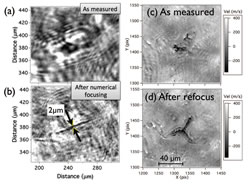
Using a tool called the velocity interferometer (VISAR) in 2D, holographic properties became apparent: numerical processing recovered some 3D information from the 2D image
LLNL 10/14/2014—A new technique for 3D-image processing a high-speed photograph can “freeze” a target’s motion and reveal hidden secrets. This technique, developed at Lawrence Livermore National Laboratory, is particularly applicable in targets that are “shocked.” Shock physics is the study of how matter subjected to a shock wave’s high pressures and densities crack, crumble, and disintegrate. The process uses a velocity interferometer (VISAR)—an instrument in widespread use in national laboratories for many years—in a novel manner. Traditionally, VISAR is used to measure a target along a line (1D measurement) or at a single point (zero-D measurement). The team instead used VISAR in 2D to make snapshot images, using high-resolution detectors similar to those in found in digital cameras, plus an extremely short laser flash to freeze the target motion. When the target accidentally moved, blurring the cracks, the researchers realized it was possible with numerical processing of the data to recover some 3D information from the 2D image—effectively doing holography—to focus features that were originally blurred. The ability to better image tiny cracks that are growing and changing, at short timescales, even when the target is moving and often out of focus, could aid in the future study of materials undergoing brittle fracture after shock loading. The findings are published in
Review of Scientific Instruments.
View LLNL Data Science Press Release
October 10, 2014 — Randles receives National Institutes of Health award to pursue cancer research

Lawrence Livermore computational scientist Amanda Randles received a Director’s Early Independence Award from the National Institutes of Health.
LLNL 10/10/2014— Lawrence Livermore National Laboratory computational scientist Amanda Randles received a Director’s Early Independence Award from the National Institutes of Health (NIH) to pursue research to develop a way of predicting likely sites for cancer to metastasize—a method that combines personalized massively parallel computational models and experimental approaches. “Building a detailed, realistic model of human blood flow is a formidable mathematical and computational challenge requiring large-scale fluid models as well as explicit models of suspended bodies like red blood cells,” Randles said. “This will require high-resolution modeling of cells in the blood stream, and necessitate significant computational advances.” The goal is to develop a method to simulate flow of realistic levels of cells through the circulatory system, thereby gaining insight into mechanisms that underlie disease progression and localization. Randles will receive about $2.5 million over five years; the NIH Common Fund award provides funding to encourage exceptional young scientists to pursue “high risk, high reward” independent research in biomedical and behavioral science.
View LLNL Data Science Press Release
October 7, 2014 — Bio researchers receive patent to fight superbugs
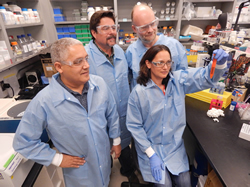
Lawrence Livermore National Laboratory scientists (front row left to right) Matt Coleman and Feliza Bourguet and (back row left to right) Brian Souza and Patrik D'haeseleer received a patent for developing a computational genomic technique to fight superbugs (antibiotic-resistant bacteria). Credit: Julie Russell/LLNL
LLNL 10/7/2014—Superbugs, or antibiotic-resistant bacteria, have been on the rise since antibiotics were first introduced 80 years ago, as a result of antibiotics having been being overprescribed and misused, allowing bacteria pathogens to develop immunities against them. As a result, superbugs sicken nearly 2 million Americans each year, of whom roughly 23,000 die. Lawrence Livermore National Laboratory (LLNL) scientists have now received a patent for producing antimicrobial compounds that degrade and destroy antibiotic-resistant bacteria by using a pathogen’s own genes against it. Their technique uses computational tools and genome sequencing to identify which genes inside a bacterium encode for lytic proteins—enzymes that normally produce nicks in cell walls that allow cells to divide and multiply. But in high concentrations, the enzymes rapidly degrade and rupture cell walls. Lytic proteins circumvent any defenses that bacteria have developed. The LLNL approach can be used to fight superbugs such as antibiotic-resistant E. coli, Salmonella, Campylobacter, Methicillin-resistant Staphylococcus aureus (MRSA), Bacillus anthracis and many others.
View LLNL Data Science Press Release
October 5, 2014 — Livermore scientists suggest ocean warming in Southern Hemisphere underestimated

The Antarctic Ocean is a remote place where icebergs frequently drift off the Antarctic coast and can be seen during their various stages of melting. This iceberg, sighted off the Amery Ice Shelf, also has bands of translucent blue ice formed by sea or freshwater freezing in bands between layers of more compressed and white glacial ice. Credit: Andrew Meijers/BAS
LLNL 10/5/2014—Using satellite observations and a large suite of climate models, Lawrence Livermore scientists have found that long-term ocean warming in the upper 700 meters of Southern Hemisphere oceans has likely been underestimated. “This underestimation is a result of poor sampling prior to the last decade and limitations of the analysis methods that conservatively estimated temperature changes in data-sparse regions,” said LLNL oceanographer Paul Durack, lead author of a paper appearing in the October 5 issue of the journal Nature Climate Change. Ocean heat storage is important because it accounts for more than 90 percent of the Earth’s excess heat that is associated with global warming. The observed ocean and atmosphere warming is a result of continuing greenhouse gas emissions. The Southern Hemisphere oceans make up 60 percent of the world’s oceans. The results suggest that global ocean warming has been underestimated by 24 to 58 percent. The conclusion that warming has been underestimated agrees with previous studies; however, this study is the first time that scientists have tried to quantify how much heat has been missed.
View LLNL Data Science Press Release
September 30, 2014 — NIH taps lab to develop sophisticated electrode array system to monitor brain activity
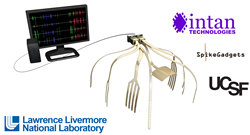
LLNL is developing an advanced electronics system to monitor and modulate neurons, to be packed with more than 1,000 tiny electrodes embedded in different areas of the brain to record and stimulate neural circuitry.
LLNL 9/30/2014—The National Institutes of Health (NIH) awarded Lawrence Livermore National Laboratory (LLNL) a grant to develop an electrode array system that will enable researchers to better understand how the brain works through unprecedented resolution and scale. LLNL’s project is part of NIH’s efforts to support President Obama’s Brain Research through Advancing Innovative Neurotechnologies (BRAIN) Initiative, a new research effort to revolutionize our understanding of the human mind and uncover ways to treat, prevent and cure brain disorders. LLNL’s goal is to develop a system that will allow scientists to simultaneously study how thousands of neuronal cells in various brain regions work together during complex tasks such as decision making and learning. The biologically compatible neural system will be the first of its kind to have large-scale network recording capabilities that are designed to continuously record neural activities for months to years.
View LLNL Data Science Press Release
September 22, 2014 — Lawrence Livermore renews pact with Georgetown University to expand research and education in science and policy
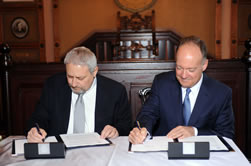
LLNL Director Bill Goldstein and Georgetown President John DeGioia sign a memorandum of understanding on Friday, renewing the LLNL-Georgetown partnership and expanding areas of collaboration. Credit: Georgetown University
LLNL 9/22/2014—Lawrence Livermore National Laboratory (LLNL) Director Bill Goldstein and Georgetown University President John DeGioia on Friday renewed their institutional commitment by signing a memorandum of understanding for an additional five years to expand the collaborative work in the areas of cyber security, biosecurity, nonproliferation and global climate, energy and environmental sciences. This renewal represents a significant expansion of an MOU originally signed in December 2009 and is a framework to broaden LLNL collaborations university-wide, including the Georgetown University Medical Center. The new MOU expands the fields of study to include data science and data analytics; bio-security; emergency and disaster management; global climate, energy and environment; food safety and security; and biotechnology (including such fields as infectious diseases, drug discovery, regenerative medicine, and urban resilience). In data analytics, projects include a potential collaboration on a new master’s degree program as well as working together to create a shared computational infrastructure leveraging LLNL’s high-performance computing capabilities.
View LLNL Data Science Press Release
September 9, 2014 — Simulating the south Napa earthquake
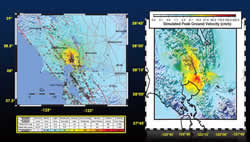
Researchers are using data from the South Napa earthquake to help validate models. These figures compare the observed intensity of ground motion from seismic stations of the California Integrated Seismic Network “ShakeMap” (left) with the simulated shaking (peak ground velocity) from SW4 simulations (right).
LLNL 9/9/2014—A Lawrence Livermore seismologist Artie Rodgers is tapping into LLNL's supercomputers to simulate the detailed ground motion of August’s magnitude 6.0 south Napa earthquake, the largest to hit the San Francisco Bay Area since the magnitude 6.9 Loma Prieta event in 1989. Using descriptions of the earthquake source from the UC Berkeley Seismological Laboratory, Rodgers is determining how the details of the rupture process and 3D geologic structure, including the surface topography, may have impacted the ground motion. Seismic simulations allow scientists to better understand the distribution of shaking and damage that can accompany earthquakes, including possible future “scenario” earthquakes. Simulations are only as valid as the elements going into them; thus the recent earthquake provides data to validate methods and models.
View LLNL Data Science Press Release
August 20, 2014 — Livermore researchers create engineered energy absorbing material

A silicone cushion with programmable mechanical energy absorption properties was produced through a 3D printing process using a silicone-based ink by Lawrence Livermore National Laboratory researchers.
LLNL 8/20/2014—Solid gels and porous foams are used for padding and cushioning, but each has its own advantages and limitations. Gels are effective but are relatively heavy and their lack of porosity gives them a limited range of compression. Foams are lighter and more compressible, but their performance is not consistent due to the inability to accurately control the size, shape and placement of voids (air pockets) when the foam is manufactured. Now, with the advent of additive manufacturing—also known as 3D printing—a team of engineers and scientists at Lawrence Livermore National Laboratory (LLNL) has found a way to design and fabricate, at the microscale, new cushioning materials with a broad range of programmable properties. LLNL researchers constructed cushions using two different configurations, and were able to model and predict the performance of each of the architectures under both compression and shear. “The ability to dial in a predetermined set of behaviors across a material at this resolution is unique, and it offers industry a level of customization that has not been seen before,” said the lead author of a paper published in the August 20 issue of Advanced Functional Materials.
View LLNL Data Science Press Release
August 19, 2014 — New project is the ACME of addressing climate change
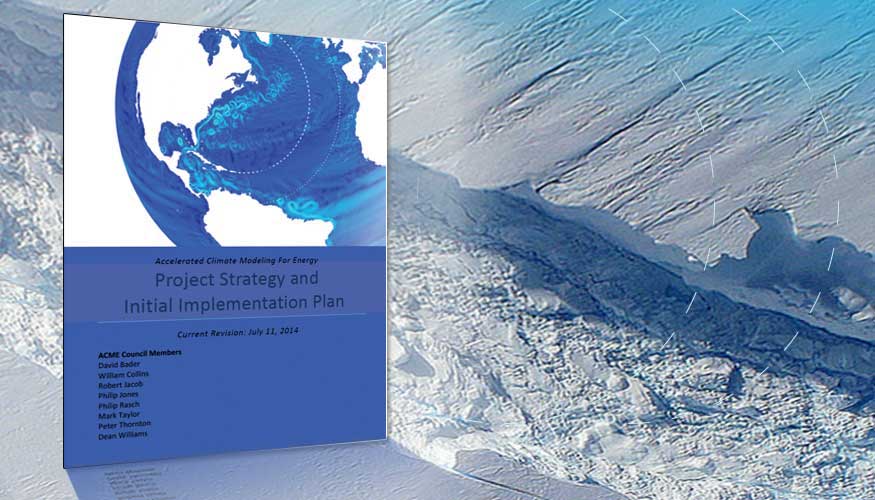
A massive crack runs about 29 kilometers (18 miles) across the Pine Island Glacier’s floating tongue, marking the moment of creation for a new iceberg that will span about 880 square kilometers (340 square miles) once it breaks loose from the glacier. The onset of the collapse of the Antarctic Ice Sheet is one area a new project headed by Lawrence Livermore will examine. Credit: Quantum Filmmakers
LLNL 8/19/14—High performance computing (HPC) will be used to develop and apply the most complete climate and Earth system model to address the most challenging and demanding climate change issues. Eight national laboratories, including Lawrence Livermore (LLNL), are combining forces with the National Center for Atmospheric Research, four academic institutions and one private-sector company in the new effort. Other participating national laboratories include Argonne, Brookhaven, Lawrence Berkeley (LBNL), Los Alamos (LANL), Oak Ridge, Pacific Northwest and Sandia. The project, called Accelerated Climate Modeling for Energy (ACME), is designed to accelerate the development and application of fully coupled, state-of-the-science Earth system models for scientific and energy applications. The plan is to exploit advanced software and new high performance computing machines as they become available. The initial focus will be on three climate change science drivers (the water cycle, biogeochemistry, and the cryosphere) and corresponding questions.
View LLNL Data Science Press Release
July 8, 2014 — DARPA taps Lawrence Livermore to develop world’s first neural device to restore memory
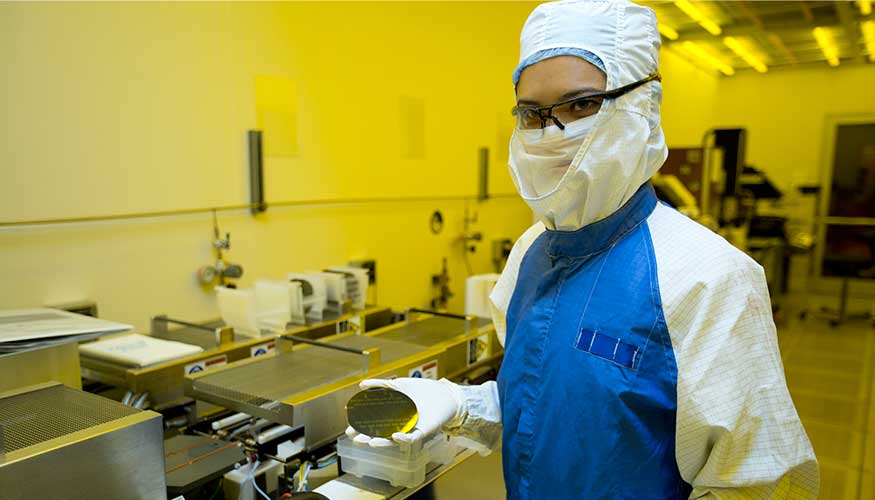
Lawrence Livermore engineer Vanessa Tolosa holds up a silicon wafer containing micromachined implantable neural devices.
LLNL 7/8/2014—The Department of Defense’s Defense Advanced Research Projects Agency (DARPA) awarded Lawrence Livermore National Laboratory (LLNL) up to $2.5 million to develop an implantable neural device with the ability to record and stimulate neurons within the brain to help restore memory, DARPA officials announced this week. The research builds on the understanding that memory is a process in which neurons in certain regions of the brain encode information, store it and retrieve it. Certain types of illnesses and injuries, including Traumatic Brain Injury (TBI), Alzheimer’s disease and epilepsy, disrupt this process and cause memory loss. TBI, in particular, has affected 270,000 military service members since 2000.
View LLNL Data Science Press Release
July 8, 2014 — Study shows design standards for dams are effective for earthquakes
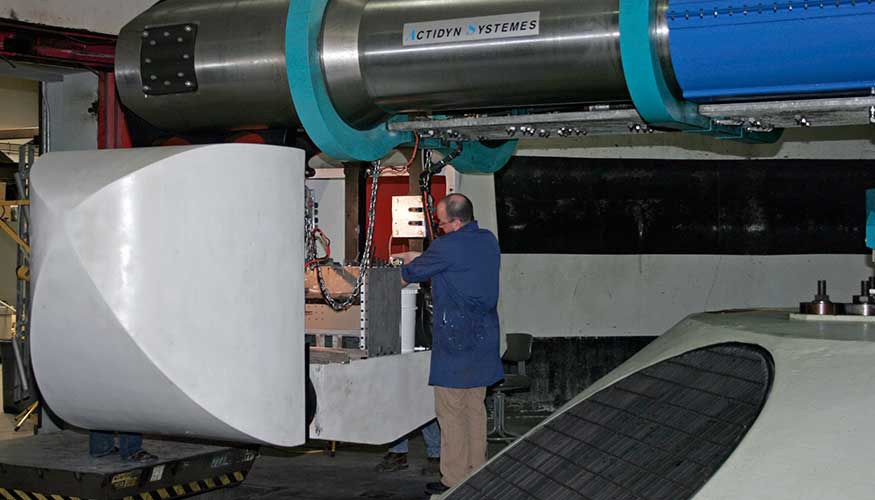
A technician prepares an experiment in the U.S. Army Corps of Engineers’ Engineer Research and Development Center’s Centrifuge Research Center. The centrifuge, the world’s most powerful, used a one-foot-high model dam and subjected it to 30 times the force of gravity to mimic a 30-foot dam and generate data to validate Lawrence Livermore National Laboratory's numerical tools and simulations.
LLNL 7/8/2014—Civil engineers have long been concerned that dams could fail days or weeks after an earthquake, even if no immediate evidence of a problem surfaced. Their concern has focused on possible cracks at the interface between the concrete section of a dam and the soil embankments at the dam’s sides, and on how the soil filters nestled amidst the embankments would fare. Since soil filters were instituted, their design standards have been based on experimental studies without detailed and validated computer modeling of the soil grains—until now. For the first time, under a collaboration between Lawrence Livermore National Laboratory (LLNL) and the U.S. Army Corps of Engineers’ Engineer Research and Development Center (ERDC), researchers have completed a study demonstrating the effectiveness of soil filters at the soil grain scale. They modeled soil filters at the grain level in 3D and then bridged the interaction of soil erosion to the behavior of the dam itself. The collaboration’s computer simulations, validated by experimental tests run by the ERDC, show that the dam filters meeting today’s existing standards for reservoirs are effective for protection.
View LLNL Data Science Press Release
June 19, 2014 — Lawrence Livermore, MIT researchers develop new ultralight, ultrastiff 3D printed materials
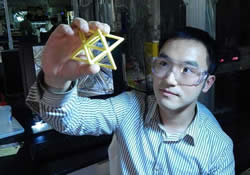
Lawrence Livermore Engineer Xiaoyu “Rayne” Zheng—lead author of the Science article—studies a macroscale version of the unit cell, which constitutes the ultralight, ultrastiff material. Photos by Julie Russell/LLNL.
LLNL 6/19/14—Imagine a material with the same weight and density as aerogel—a material so light it is sometimes called ‘frozen smoke’—but with 10,000 times more stiffness. Such a material could have a profound impact on the aerospace or automotive industries and other applications where lightweight, high-stiffness and high-strength materials are needed. Lawrence Livermore National Laboratory (LLNL) and Massachusetts Institute of Technology (MIT) researchers have developed a material with these properties using additive micro-manufacturing processes, designed with the aid of supercomputer modeling. The research team’s findings are published in the June 20 issue of Science. Titled “Ultralight, Ultrastiff Mechanical Metamaterials,” the article describes the team’s development of micro-architected metamaterials—artificial materials with properties not found in nature that maintain a nearly constant stiffness per unit mass density, even at ultralow density.
View LLNL Data Science Press Release
June 16, 2014 — Researchers develop efficient approach to manufacture 3D metal parts
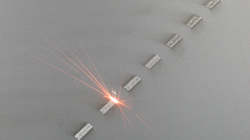
Direct metal laser melting (DMLM) machine in action: A laser fuses metal powder to form one of many successive layers that will form the final manufactured part.
LLNL 6/16/14—Selective laser melting (SLM) is a powder-based, additive manufacturing process where a three-dimensional (3D) mechanical part is produced, layer by layer, using a high-energy laser beam to fuse particles of metal powder. Some devices or mechanisms require parts that are very dense, with less than 1 percent porosity, as the pores or voids are the weakest part of the material and most likely would result in failure. A challenging problem in additive manufacturing has been selecting the appropriate process parameters to build up mechanical parts with desired properties. Lawrence Livermore National Laboratory (LLNL) researchers have how developed a new and more efficient approach to identify optimal parameters to print 3D high-density metal parts. Their paper, recently published in the International Journal of Advanced Manufacturing Technology, explains how parameters for higher-power SLM machines can be selected by using simple computational simulations to explore the process parameter space. The simulations compute the dimensions of the pool of liquid formed when the laser melts the metal powder particles.
View LLNL Data Science Press Release
June 11, 2014 — Lawrence Livermore Lab awarded $5.6 million to develop next generation neural devices

This rendering shows the next generation neural device capable of recording and stimulating the human central nervous system being developed at Lawrence Livermore National Laboratory. The implantable neural interface will record from and stimulate neurons within the brain for treating neuropsychiatric disorders.
LLNL 6/11/14—Lawrence Livermore National Laboratory (LLNL) recently received $5.6 million from the Department of Defense’s Defense Advanced Research Projects Agency (DARPA) to develop an implantable neural interface with the ability to record and stimulate neurons within the brain for treating neuropsychiatric disorders. The technology will help doctors to better understand and treat post-traumatic stress disorder, traumatic brain injury, chronic pain, and other conditions. LLNL and Medtronic are collaborating with UC San Franciscso, UC Berkeley, Cornell University, New York University, PositScience Inc., and Cortera Neurotechnologies on the DARPA SUBNETS project. Some collaborators will be developing the electronic components of the device, while others will be validating and characterizing it.
View LLNL Data Science Press Release
May 14, 2014 — Two Lawrence Livermore researchers awarded early career funding
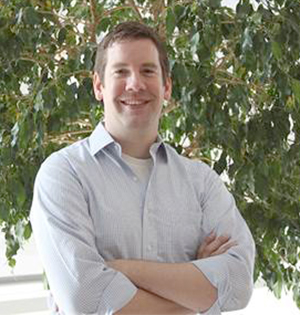
Lawrence Livermore computer scientist Todd Gamblin will receive up to $2.5 million in funding to accelerate the adaptation of scientific simulation codes to increasingly powerful supercomputers.
LLNL 5/14/14—Todd Gamblin, a computer scientist in Lawrence Livermore National Laboratory’s (LLNL) Center for Applied Scientific Computing, will receive up to $2.5 million in funding over five years for a project to accelerate the adaptation of scientific simulation codes to increasingly powerful supercomputers. A process that currently can take up to six months for complex applications, increasingly complex machine architectures and applications are making this process even slower. Under a project entitled “Statistical Methods for Exascale Performance Modeling,” Gamblin proposes to develop statistical models of applications that can represent adaptive, data-dependent code behavior in a manner that can be scaled up for more powerful computing systems. In addition, the project will develop techniques to reduce the complexity of application models, so that application developers understand them.
View LLNL Data Science Press Release
May 6, 2014 — First-of-a-kind supercomputer at Lawrence Livermore available for collaborative research
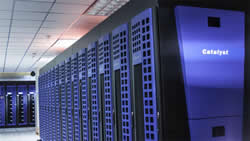
The Catalyst supercomputer at Lawrence Livermore employs a Cray CS300 architecture modified specifically for data-intensive computing. The system is now available for collaborative research with industry and academia.
LLNL 5/6/14—Catalyst, a first-of-a-kind supercomputer at Lawrence Livermore National Laboratory (LLNL), is available to industry collaborators to test big data technologies, architectures and applications. Developed by a partnership of Cray, Intel and Lawrence Livermore, this Cray CS300 high performance computing (HPC) cluster is available for collaborative projects with industry through Livermore's High Performance Computing Innovation Center (HPCIC). “Catalyst allows us to explore entirely new deep learning architectures that could have a huge impact on video analytics as well as broader application to big data analytics,” said Fred Streitz, director of the HPCIC.
View LLNL Data Science Press Release
April 14, 2014 — Proposals sought for next-generation supercomputing technologies
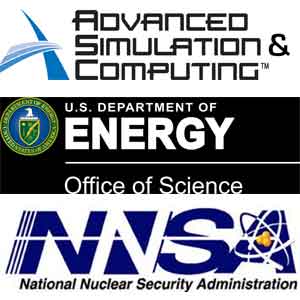
LLNL 4/14/14 — The U.S. Department of Energy's (DOE) Office of Science and the National Nuclear Security Administration (NNSA) have issued a request for proposals to further develop "extreme scale" supercomputer technology. The latest request for proposals is now available on the Web. Contracts will total about $100 million, and the funding period will be from July 2014 to November 2016. Proposals, under what is being called FastForward 2, will be due May 9. FastForward seeks proposals from any company interested in working on extreme scale node architectures or memory technologies. Vendors from the computing industry are awarded research contracts to accelerate technologies critical to the development of next-generation, extreme scale supercomputers, which will provide the necessary simulation and computing capabilities to achieve DOE’s missions of national defense, scientific research and energy security.
View LLNL Data Science Press Release
April 2, 2014 — Americans using more energy according to Lawrence Livermore analysis
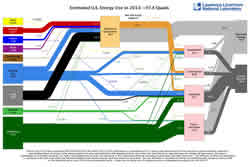
The 2013 energy flow chart released by Lawrence Livermore National Laboratory details the sources of energy production, how Americans are using energy and how much waste exists. (Credit: LLNL)
LLNL 4/2/14 — Americans used more renewable, fossil, and nuclear energy in 2013 than in 2012, according to the most recent energy flow charts released by Lawrence Livermore National Laboratory. Each year, the Laboratory releases energy flow charts that illustrate the nation’s consumption and use of energy. Overall, Americans used 2.3 quadrillion thermal units more in 2013 than the previous year. The Laboratory also has released a companion chart illustrating the nation’s energy-related carbon dioxide emissions. Americans' carbon dioxide emissions increased to 5,390 million metric tons, the first annual increase since 2010.
View LLNL Data Science Press Release
February 27, 2014 — LLNL's ‘Science On Saturday’ lecture explains the cardioid project
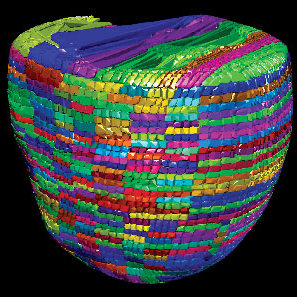
The Cardioid code developed by a team of Livermore and IBM scientists divides the heart into a large number of manageable pieces, or subdomains. The development team used two approaches, called grid (above) and Voronoi (not shown), to break the enormous computing challenge into much smaller individual tasks. See https://str.llnl.gov/Sep12/streitz.html
LLNL 2/17/14 — Computer modeling is a powerful tool for scientific inquiry when experiments are too costly, too dangerous or simply impossible. In this talk, presenters describe how to build a computer model of a human heart, starting from an individual cell and then using data from an actual person to create a realistic representation of a beating heart. Examples showed how doctors and researchers may soon be able to use such simulations to investigate the effects of new drugs on cardiac rhythms or improve the success rate of complex surgical procedures.
View LLNL Data Science Press Release


















